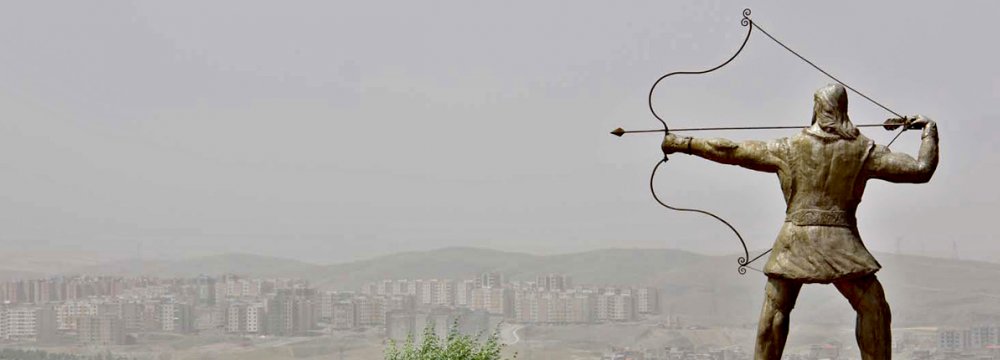Air pollution has emerged as the deadliest form of pollution and the fourth leading risk factor for premature deaths worldwide after metabolic risks (elevated blood pressure, obesity and blood glucose), dietary risks, and tobacco smoke.
According to the World Health Organization, Ischemic heart disease, stroke, chronic obstructive pulmonary disease, lung cancer, and acute lower respiratory infections in children are responsible for 40%, 40%, 11%, 6%, and 3% of all outdoor air pollution-related deaths, respectively, the WHO website reported.
“Half of all deaths in Iran occur due to heart attack and stroke which are closely linked to exposure to air pollution,” says Reza Malekzadeh, deputy health minister.
According to a new report ‘Death in the Air’ published recently by the World Bank, diseases associated with air pollution have caused about 7% of all premature deaths in the Middle East and North Africa (MENA) in 2013.
“Iran and Egypt are among the worst affected countries, both in terms of estimated numbers of air pollution-related deaths and economic costs caused by the deaths,” the report says.
Premature Deaths
Based on figures released by the Iranian Health Ministry, annually around 375,000 deaths are registered in the country, of which 40% are premature or under-70 deaths.
Given the fact that air pollution-related deaths constitute 7% of all premature deaths in the MENA region, the number of such deaths can be estimated at 10,500-11,000 deaths per year. The figure may be even higher as the percentage of air pollution-related deaths is not 7% in all countries in the region and is slightly higher in Iran and Egypt, according to the report.
The figure is only 30% less than the country’s average road death toll which is around 16,000 deaths per year.
According to figures released by the National Organization for Civil Registration (NOCR) during the last seven months of the current fiscal year (started March 20), 4,482, 4292, 4366, 4373, 4438, 4271, 4,285, and 4,799 deaths respectively were registered in Tehran Province.
The figures indicate that there is a significant difference between the average number of registered deaths during the first seven months of the year and the number of deaths registered in the 8th month (October 22-November 21).
The sharp increase in the figure can be attributed to poor air quality during the month. Authorities in the capital shut down all schools on November 16 (primary schools were closed since November 14) due to the alarming air pollution levels as a thick layer of smog covered the city.
On November 15, the Air Quality Index (AQI) showed a “red status” warning indicating that the air is unhealthy. According to the index, the intensity of the tiny particles known as PM 2.5 was at nearly 150 micrograms per cubic meter.
Meanwhile, the Tehran Air Quality Control Company said on Tuesday (Nov. 22) that the intensity of PM 2.5 had dropped to nearly 50 micrograms per cubic meter, after favorable precipitation during the last three days.
Economic Consequences
Based on a study published in the Iranian Journal of Public Health in 2012, mortality risk for the population aged 30 and over living in Tehran could be significantly reduced if the WHO-recommended annual average PM2.5 standards were met. The annual economic benefits of this reduced risk were estimated at $378.5 million.
The economic loss is usually calculated by multiplying two variables of years of potential life lost (an estimate of the average years a person would have lived if he/she had not died prematurely) and national income per capita (which was estimated at $4,763 in 2013). However other indirect costs like days in hospital, visits to the doctors, medicines, and diagnostic cares, etc should be also considered.
The suggested ways to reduce air pollution are regular monitoring and analysis of air pollution, and regulatory reforms and interventions in sectors such as transport, energy and urban planning.
Fine Particulate Air Pollution
One of the most damaging pollutants is PM2.5, tiny particles about 1/30th the width of a human hair, which can penetrate deep into people’s lungs and are known to cause deadly illnesses such as lung cancer and heart disease.
The 2013 World Bank report categorized all the world’s countries in three groups: countries with average outdoor PM2.5 pollution level below WHO guideline; countries with PM2.5 concentration of between 10 and 35 micrograms per cubic meter; and countries with average PM2.5 level of higher than 35 micrograms per cubic meter.
Iran, Turkmenistan, Uzbekistan, Pakistan, Saudi Arabia, north India, China, and North Africa were categorized in the third group.
India lost 1.4 million lives to air pollution in 2013, while in China the toll was 1.6 million, the report estimated.






Add new comment
Read our comment policy before posting your viewpoints